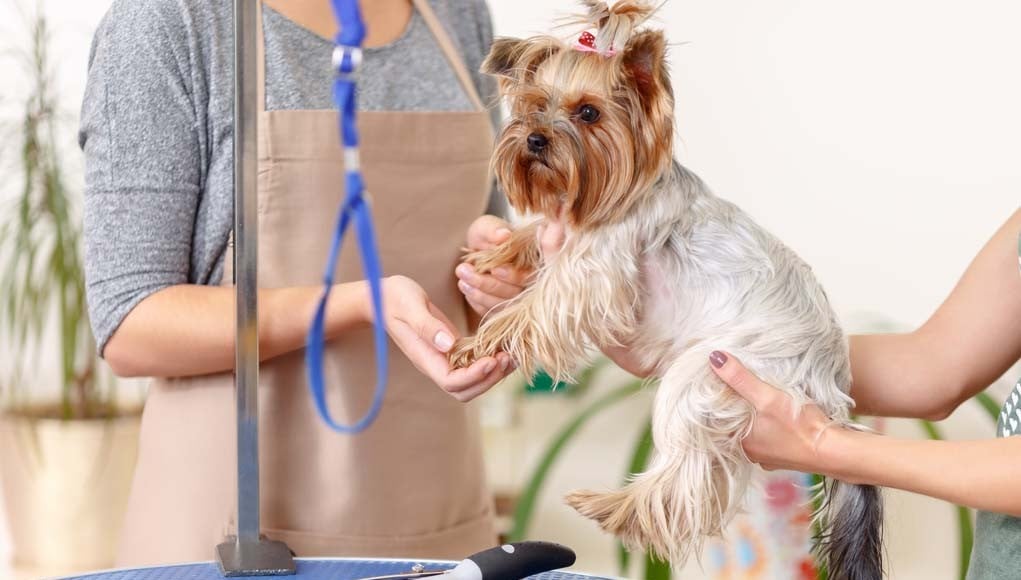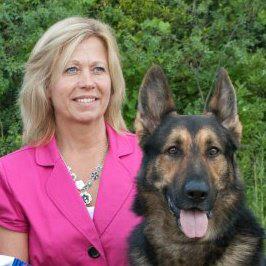 I never know what kinds of leads I'll get for interviews, but one thing is for sure – they're always with really interesting people. Lisa Parsons is a professional dog groomer located in Ontario, Canada, and her rottweiler Laush is also helping her make a name for herself in the professional dock jumping world. I was fortunate enough to be able to have a conversation with Lisa this week, and she shared a lot of great professional dog grooming information with me. I hope you guys like what we got out of this interview!
I never know what kinds of leads I'll get for interviews, but one thing is for sure – they're always with really interesting people. Lisa Parsons is a professional dog groomer located in Ontario, Canada, and her rottweiler Laush is also helping her make a name for herself in the professional dock jumping world. I was fortunate enough to be able to have a conversation with Lisa this week, and she shared a lot of great professional dog grooming information with me. I hope you guys like what we got out of this interview!
Lisa is the proud owner of Canine Styles by Lisa. She has been grooming for over 25 years, with experience in both pet and show grooming.
Lisa is a member of both the Ontario Dog Groomers Association (ODGA) and the National Association for Professional Creative Groomers (NAPCG).
Lisa's grooming philosophy is that creating a stress-free atmosphere is important for every dog's spa experience. She only uses natural products in her salon, and her clients can receive uber relaxing services like a Jacuzzi tub, sugar scrub or a foot soak. She takes her time with each dog that she grooms to help calm anxiety – if a pup needs a break, she gives him one.
Lisa got into grooming and showing dogs at about the same time. She was showing rottweilers and Siberian huskies, and of course the dogs needed to be groomed for the shows. Talk about multi-tasking – she was learning to be a professional show handler and a professional groomer at the same time.
Lisa wasn't raised in a dog showing family, and she never worked for a professional handler. She simply went to a dog show and thought it looked like a lot of fun. She took a few classes and studied under a show judge to learn the ins and outs of the industry.
When it was time to obtain her first dog she went to a professional breeder who claimed they had a show quality pup. Unfortunately the pup wasn't show quality. Lisa explained to me that like anything else, there is a large learning curve when getting into the business of dog showing.
Dogs need to be groomed for shows, but when you're on a budget you can save yourself a lot of money by learning to groom your dogs yourself. Lisa went to school and took professional training classes. She used to groom other dogs for show as well as her own, but she doesn't do that anymore.
RELATED: Are Dog Grooming Schools Worth It?
In fact, Lisa says that she no longer has any desire to professionally handle dogs. The confirmation side of dog showing just doesn't appeal to her. She said that it's very stressful, and she'd rather be involved in showing her dogs for performance. That's where Laush comes in. He's a 130-pound rottweiler who is making a big splash in the world of professional canine dock jumping.
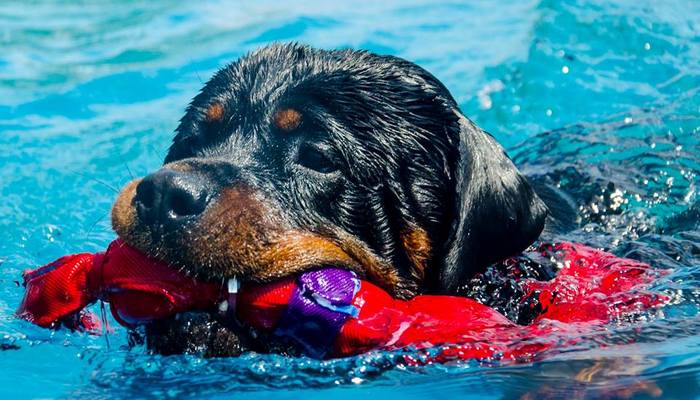
Unfortunately, dock jumping doesn't pay the bills. That's why Lisa owns and operates Canine Styles by Lisa. She is the only groomer, but she does have an assistant that helps to bathe and brush the dogs. Lisa spoke with me about owning her own professional dog grooming business and gave me some great tips for pet parents.
The Scoop on Professional Dog Grooming
As interesting as showing dogs is, I really wanted to know more about the grooming aspect of Lisa's career. As she mentioned, she did have formal groomer's training and she took professional animal grooming classes, but Lisa also told me that most of her education came from hands-on experience.
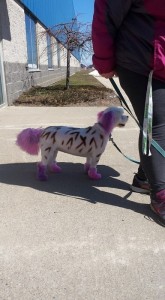
She explained that dog groomers get more experience when they're actually working with the dogs in a grooming facility than they do in a classroom. At Canine Styles by Lisa, she grooms all breeds, and she specializes in creative grooming. She focuses on skin and coat diseases and helps educate pet parents on the best way to care for their particular dog.
I've noticed that skin and coat issues seem to be becoming a much more prevalent problem for pets and their owners. Lisa says that she's seeing it too. She believes that this increase is due to more environmental toxins, more required vaccinations, and more allergies to pet foods.
RELATED: Best Professional Dog Hair Clippers
Lisa was telling me a story of a wheaten terrier that came into her shop recently with skin issues. The dog's vet had given her something for her skin, but during the same visit had also given her a heartworm treatment, multiple vaccines, and Revolution (a topical treatment). The owners were baffled as to why the skin condition wasn't clearing up, and Lisa knew it was due to all the chemicals that were recently put in the dog's system and onto her skin.
With all due respect to veterinarians, they don't specialize in skin and coat conditions. General practicing vets are educated on a dog's overall health and well-being. They learn about their organs, their skin and coat, their eyes, etc… They can diagnose most common issues, but they don't receive any specialized training on specific areas of the canine body.
For example, when our boxer was diagnosed with cardiomyopathy our vet was able to diagnose the issue, but she recommended that we see a canine cardiologist for advice on treatment. Unfortunately, canine skin and coat issues can be caused by many things, and unless you see a dog dermatologist you may not get immediate answers.
Since groomers work so closely with a pet's skin and coat, they often can give pet parents insight into any issues that may arise. Of course, they won't diagnose anything, but they will tell you a bit about what's going on and ways you may be able to help your pet.
Lisa told me that commercial dog food is one of the leading causes of skin and coat issues in dogs. She said that if one of her clients is shedding excessively or having health issues with his skin or coat, she always recommends that the owner look at the food they are feeding. She hopes they follow her recommendations, but obviously not everyone does.
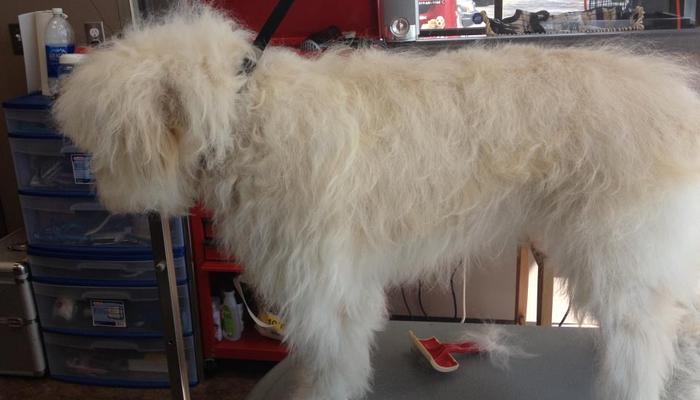
I was curious as to which issues Lisa sees most often that pet parents overlook. She said most dog owners aren't aware of ear issues. Lisa explained that the first indication of a food allergy is a problem with your pet's ears. She said that a yeasty ear is a good sign that your dog has a grain sensitivity. She also told me that tear stains, which are common with many dogs, are a sign that your dog has a protein sensitivity.
I asked Lisa what advice she would give her clients whose pets were suffering with these issues. She says that many times when a pet has a skin condition, owners will request an oatmeal shampoo – even if the skin condition is caused by a grain allergy. They don't realize that oatmeal is a grain and putting it topically on the skin can be just as harmful as ingesting it. She advises her clients to be mindful of the ingredients in every product they use, not just the food they are feeding their pet.
RELATED: How to Start a Dog Grooming Business
She also explained that if a dog has tear stains it is important to switch the protein source in his food, but not the brand. For example, if you feed your pet Call of the Wild dog food and you usually get him the bison blend, try switching to the salmon blend instead. By switching the protein source you will likely clear up the tear stains, and your dog won't have to get used to an entirely new dog food.
All dogs need professional dog grooming. No matter what breed your beloved pup is, he'll need some professional care from a well trained groomer. All dogs need brushing, nail clipping, ear care and other general grooming. Of course, you can do some of this at home, but Lisa recommends all pet parents bring their dog to the groomer once every 6 to 8 weeks.

Finally, I wanted to know what advice Lisa would give to pet parents who are looking for a groomer for their dog. She said that due to very loose regulations on professional groomers, pet owners need to be serious about asking questions like, “where did you go to school?” and “can I see your facility?”
Lisa recommends that you walk away if a groomer tells you that you can't see the facility or can't pop in at any time. She cautions pet parents to remember that cheaper isn't always better, and more expensive isn't always better either. You need to be cautious when looking for a groomer. I think Lisa said it best when she told me:
“You wouldn't drop your child off to have their haircut without thinking that the person was absolutely capable at the other end of the scissors or clippers, and that you're going to get your child back with both their ears. We get horror stories about dogs having their ears cut while grooming…So educate yourself properly on how to find a good groomer.”
She also told me that it's the groomer's responsibility to educate pet parents on the proper tools to use on their pet in between professional dog grooming – a job that she takes very seriously. She recommends that every pet parent have at least a brush, comb, an appropriate shampoo, a leave-in conditioner for dogs that have hair, and a rubber brush for dogs with fur. Unsure if your dog has hair or fur? Fur grows to a predetermined length and then stops, and hair continues to keep growing (like human hair).
Dog groomers are a great resource for pet parents. Even though you may not be able to afford to take your pet in every 2 months, you should still consult with a groomer. They can give you advice and tips for caring for your dog's grooming needs at home, and they'll be able to give you a better idea of how often your pet really needs to be seen. Some breeds, like a Shih Tzu, need to be seen more often for regular cuts, but others may be able to go longer without professional grooming as long as their needs are being met at home.
I would like to thank Lisa for sharing her experiences and advice on grooming dogs with our readers. Remember to check out Lisa's website at Canine Styles by Lisa, and let us know what you thought of this interview on dog grooming in the comments below!


